Angela Ackerman's Blog: Writers Helping Writers, page 23
April 25, 2024
Does Your Scene Need More Tension? Add an Emotion Amplifier!
Emotion and tension often go hand in hand. If character emotion is low, story tension is also probably waning. On the flip side, tension is likely on the rise when emotion is high and it���s written effectively.
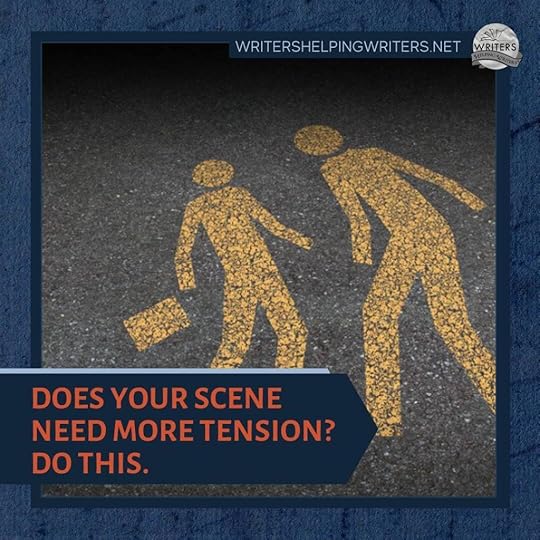
Dramatic tension is the feeling of anticipation surrounding what happens next. It���s the golden ticket for reader interest, because when a character is in trouble and the outlook is grim, readers worry. This worry translates into empathy and a need to read on to see if the character will be okay. For this reason, it���s important to keep the tension in each scene at an engaging level.
Consider the first book in The Hunger Games trilogy by Suzanne Collins. Tension is high throughout the story because of the primal stakes: death is constantly on the line. But Collins ramps it up even more by adding stressors in the form of amplifiers. At the start of the games, she removes fresh water from the arena, threatening dehydration and adding another life-threatening factor to worry about. She introduces the tracker jackers and their psychosis-inducing stings, increasing reader suspense and fear for Katniss���s safety while she���s incapacitated. After Rue���s death, Katniss slips into a period of bereavement that���s almost as worrying to readers as her delusions, because anything could happen to her in such a vulnerable state.
Like a sadistic head gamemaker, Collins never lets the heroine off the hook. She continues to throw Katniss new and more alarming problems that make it more difficult to survive an already impossible situation. And the agony pays off. Each new amplifier accomplishes two important things for the character and the reader.
1) Katniss experiences elevated stress. We���ve already covered the impact of emotional stress on a character, and this example demonstrates how stress makes it difficult for Katniss to think clearly and make the best decisions. Poor choices lead to bigger problems, which causes more stress . . . It���s a continuing cycle that keeps readers riveted as the tension rises from page to page.
2) These amplifiers heighten Katniss���s emotions to the point that they can���t be ignored. With each new stressor, she grows more afraid, paranoid, angry, or depressed. As readers, we feel those emotions right along with her. We���re drawn into her story and root for her in a way that guarantees we���ll keep reading to the very end.
If you suspect the tension is flagging in your story or scene, it could be time to add an emotion amplifier. Pain, arousal, dehydration���conditions and states like these make it difficult for a character to self-regulate and think things through logically, increasing the chance they’ll make bad choices and mistakes. Here are a few examples of how amplifiers can be used to jack up the tension.
To Introduce TemptationMandy���s a smart kid, but in her financial situation, the only way she���s getting into college is with a sports scholarship. Rumors are swirling about scouts coming to the next game, so she needs to outdo herself on the field.
Unfortunately, daily practices, community service hours, and homework make it hard for her to prepare, and her stupid busy schedule has left her exhausted. She can���t possibly do her best in this game. But then she remembers that guy in AP Chemistry, the one who sells Adderall to kids looking for a pick-me-up. Mandy has never stooped to that level���she doesn���t use drugs���but she���s so tired and has worked so hard. Maybe a little boost would be okay, just this once . . .
Here, the temptation to use a stimulant to overcome exhaustion tips the balance of Mandy���s internal weighing-and-measuring process as her desire for short-term relief threatens to override her morals. Readers have much more to worry about now than whether Mandy will perform well at the game; we all know the danger of just this once. If she gives in, this moment could morph into a secret she���ll have to hide or an addiction that could put all her goals in jeopardy.
To Force Difficult DecisionsSince his wife���s death, Juan has raised their three young kids by himself in a rural, impoverished village. Relocating to a better area with more opportunities would require an arduous trek through the jungle, and for that, they���d need to be strong and healthy, a challenge considering the lack of resources and clean water.
Then one day, food supplies to the village are cut off. As hunger sets in, Juan is faced with an impossible decision: leave now, knowing not all his children will survive the trip, or stay and hope against hope that things turn around.
In this heartbreaking scenario, things start out bad enough as Juan struggles to manage his family���s unstable circumstances on his own. The addition of hunger not only exacerbates the situation, but it also creates a horrible Sophie���s choice dilemma. It���s a no-win scenario because whatever he chooses, pain and regret will follow.
To Increase VulnerabilityThe number seven bus squeals to a stop and the doors wheeze open. Ed gingerly exits, favoring his bad hip. Eager to get home, he shuffles along a cracked sidewalk bordering a row of buildings with torn awnings and graffiti-scrawled walls. Wait. This isn���t right. Where���s the park entrance and tall pines lining his route home?
The bus pulls back into traffic, and Ed���s heartbeat stutters. He���d gotten off at the fourth stop. That was the way home. Or was that to get to the doctor���s office?
A group of young people slouch nearby, smoking something pungent and eyeing him. One peels away from the building he���s leaning against. ���Hey, old man. You lost?���
���I . . . I don���t know.��� Where was he? And where was he supposed to be going?
This senior is far from home in a not-so-safe area, and our uncertainty about the intentions of the local boys increases the dramatic tension. When it becomes clear that Ed is also dealing with cognitive decline, our worry escalates because his mental fog pushes the situation from unsettling to dangerous. Vulnerability always enhances an already tense situation, and it���s a natural offshoot of many amplifiers, so keep it in mind when you need to up the ante.

Exhaustion. Hunger. Cognitive Decline. See how well emotion amplifiers juice a scene with tension? And this is just one of their functions. So useful!
The Emotion Amplifier Thesaurus: A Writer’s Guide to Character Stress and Volatility releases May 13th. If you’d like a notification when it’s available, add your email here if you’ve not yet done so, or head over to Goodreads and add it to your reading list.
The post Does Your Scene Need More Tension? Add an Emotion Amplifier! appeared first on WRITERS HELPING WRITERS��.
April 23, 2024
A Mother Lode of Resources on Talents and Skills
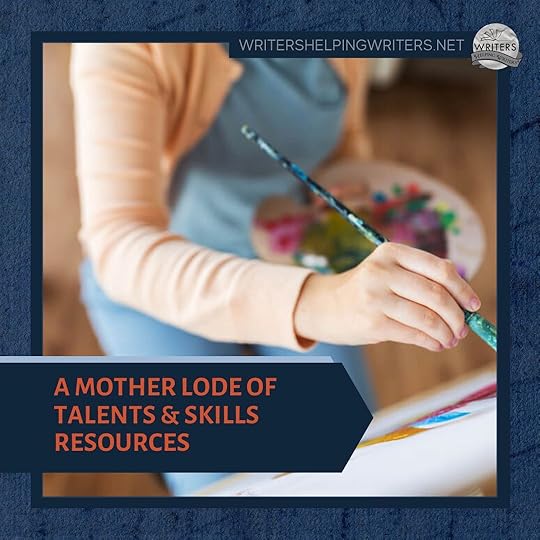
Talents and skills can serve many purposes in a story by revealing truths about the character, making them more likable or relatable for readers, and contributing to story arc by helping the character achieve their goals. As such, they can do a lot of good things for our stories and characters���if they’re chosen well.
This is why Angela and I created the Talent and Skill Thesaurus at Writers Helping Writers. We wanted authors to have a resource that could help them explore special abilities they might want or need in their story. With over 60 entries, it’s a great jumping-off point for figuring out what your character might be good at.
It may not seem like it, but there’s a lot to think about when you’re making this decision for a character. So we’ve compiled a list of posts to help you learn about identifying talents and skills for your character and incorporating them into a story.
Helpful Posts
4 Reasons Your Hero Needs a Talent
7 Ways a Talent or Skill Will Enhance Your Story
Using Talents and Skills to Characterize
Make Your Character Unique with a Talent or Skill
How a Skill Can Liven Up a Quiet Protagonist
How to Use Hobbies to Flesh Out a Character
Add a Talent to Make a Character More Likable
If you found this collection of resources helpful, you might be interested in some of our other compilation posts.
How to Write about Character Occupations
How to Show (Not Tell) Character Emotions
How to Create Phenomenal First Pages
How to Write Conflict that Has Maximum Impact
How to Write about Your Character���s Pain
How to Write about a Character’s Emotional Wounds
The post A Mother Lode of Resources on Talents and Skills appeared first on WRITERS HELPING WRITERS��.
April 20, 2024
Character Type & Trope Thesaurus: Cowboy
In 1959, Carl Jung first popularized the idea of archetypes���”universal images that have existed since the remotest times.” He posited that every person is a blend of these 12 basic personalities. Ever since then, authors have been applying this idea to fictional characters, combining the different archetypes to come up with interesting new versions. The result is a sizable pool of character tropes that we see from one story to another.
Archetypes and tropes are popular storytelling elements because of their familiarity. Upon seeing them, readers know immediately who they’re dealing with and what role the nerd, dark lord, femme fatale, or monster hunter will play. As authors, we need to recognize the commonalities for each trope so we can write them in a recognizable way and create a rudimentary sketch for any character we want to create.
But when it comes to characters, no one wants just a sketch; we want a vibrant and striking cast full of color, depth, and contrast. Diving deeper into character creation is especially important when starting with tropes because the blessing of their familiarity is also a curse; without differentiation, the characters begin to look the same from story to story.
But no more. The Character Type and Trope Thesaurus allows you to outline the foundational elements of each trope while also exploring how to individualize them. In this way, you’ll be able to use historically tried-and-true character types to create a cast for your story that is anything but traditional.
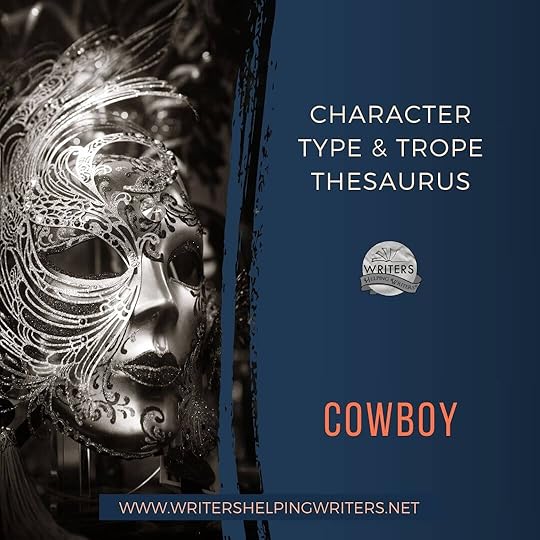
DESCRIPTION: The traditional cowboy or rancher.
FICTIONAL EXAMPLES: Ennis Del Mar and Jack Twist (Brokeback Mountain), Woody (the Toy Story franchise), Curly (City Slickers), John Dutton (Yellowstone)
COMMON STRENGTHS: Adventurous, Alert, Calm, Confident, Courageous, Decisive, Disciplined, Honorable, Humble, Independent, Industrious, Nature-Focused, Observant, Patient, Persistent, Resourceful, Simple, Traditional
COMMON WEAKNESSES: Abrasive, Cocky, Impulsive, Inflexible, Macho, Rebellious, Reckless, Stingy, Stubborn, Tactless, Uncooperative, Uncommunicative
ASSOCIATED ACTIONS, BEHAVIORS, AND TENDENCIES
Preferring solitude
Being a hard worker
Having simple needs���not being fussy about what they eat or where they sleep
Preferring to be outdoors
Having strong knowledge of local plant and animal life
Having a way with animals and being fond of them
Being humble
Being stoic; not showing much emotion
Rejecting any organization or person trying to exert authority over them
Resisting change and progress
Believing in vigilante justice
SITUATIONS THAT WILL CHALLENGE THEM
Having to spend time in an urban environment
Being stuck with someone who is entitled or ���soft���
Meeting someone he���s interested in who is very different from him
A situation where he has to ask for help
TWIST THIS TROPE WITH A CHARACTER WHO���
Likes to work with others
Is from a culture or religious background that���s different from the people around him
Is able to appreciate moral and ethical complexities
Has an atypical trait: Extroverted, Gentle, Materialistic, Philosophical, Verbose, etc.
CLICH��S TO BE AWARE OF
The lone wolf character who has no friends except his horse
The cowboy who only sees the world in black and white
Tough and gruff cowboys
Other Type and Trope Thesaurus entries can be found here.
 Need More Descriptive Help?
Need More Descriptive Help?While this thesaurus is still being developed, the rest of our descriptive collection (16 unique thesauri and growing) is accessible through the One Stop for Writers THESAURUS database.
If you like, swing by and check out the video walkthrough for this site, and then give our Free Trial a spin.
The post Character Type & Trope Thesaurus: Cowboy appeared first on WRITERS HELPING WRITERS��.
April 17, 2024
Phenomenal First Pages Contest – Guest Editor Edition

Hey, wonderful
writerly people!
It���s time for Phenomenal First Pages, our monthly critique contest. So, if you need help with the beginning of your novel, today’s the day to enter for a chance to win professional feedback.
Two winners will receive feedback on their first 20 pages!Entering is easy. All you need to do is leave your contact information on this entry form (or click the graphic below). If you are a winner, we’ll notify you and explain how to send us your pages.
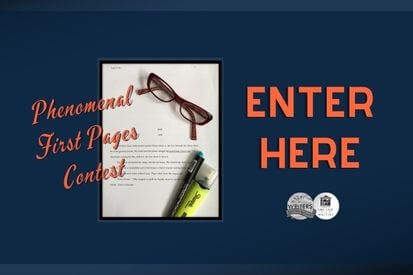 Contest DetailsThis is a 24-hour contest, so enter ASAP.Make sure your contact information on the
entry form
is correct. Two winners will be drawn. We will email you if you win and let you know how to submit. Please have your first 20 pages ready in case your name is selected. Format it with��1-inch margins, double-spaced, and 12pt Times New Roman font.��You���ll need to supply a
synopsis
(a rough one is fine) so Stuart has context for his feedback.The editor you’ll be working with:Stuart Wakefield
Contest DetailsThis is a 24-hour contest, so enter ASAP.Make sure your contact information on the
entry form
is correct. Two winners will be drawn. We will email you if you win and let you know how to submit. Please have your first 20 pages ready in case your name is selected. Format it with��1-inch margins, double-spaced, and 12pt Times New Roman font.��You���ll need to supply a
synopsis
(a rough one is fine) so Stuart has context for his feedback.The editor you’ll be working with:Stuart Wakefield

With 26 years in theatre, broadcast media, and coaching under my belt, I have a visceral understanding of what makes stories work, and I���d like to share it with you because writing a novel doesn���t always have to be difficult and daunting, especially if it���s your first time. Understanding the process, getting started, and seeing it all come together can seem like an impossible mountain to climb.
As an Author Accelerator Certified Book Coach, I���m passionate about helping new writers craft stories with passion and purpose, momentum and meaning. I have an MA (Distinction) in Professional Writing, and my debut novel, Body of Water, was one of ten books long-listed for the Polari First Book Prize. My latest novel, Behind the Seams, was a 2021 BookLife Fiction Prize Contest semifinalist.
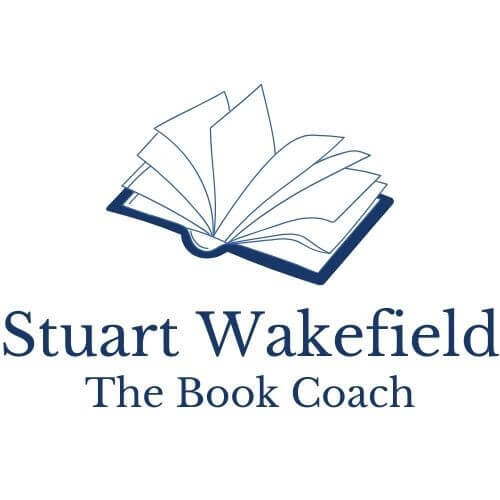
My first TV show aired on the UK���s Channel 4 in 2023.
So, if you have a story in your heart, just waiting to be shared with the world, I���m here to offer you guidance and support from developing your story right through to pursuing publication. You can find my website, blog, and free self-editing cheat sheet right here: https://linktr.ee/thebookcoach
Sign Up for Notifications!If you���d like to be notified about our monthly Phenomenal First Pages contest, subscribe to blog notifications in this sidebar.
Good luck, everyone. We can’t wait to see who wins!
PS: To amp up your first page, grab our First Pages checklist from One Stop for Writers. For more help with story opening elements, visit this Mother Lode of First Page Resources.
The post Phenomenal First Pages Contest – Guest Editor Edition appeared first on WRITERS HELPING WRITERS��.
April 16, 2024
Three Easy Steps to Generate a Goal Using Fear as Motivation

There���s so much emphasis on making sure that we give our character a goal that���s clear starting from their very first scene. Win the game. Find someone to marry. Land the job. Solve the crime.
We tend to think about goal in terms of the character obtaining the thing they don���t have when the story begins. It���s out there. They can grab it, touch it, and get it if they just do the right things and keep going.
But what if you���re like me and so many of my clients, completely unsure of what your character wants, much less why? What if they���re not an athlete, or in a personal crisis, or craving revenge right out of the gate? What if there isn���t a big mystery to solve starting in your first scene?
Cue creative crisis!
If our character isn���t trying to land a record deal or catch a killer or get some other obvious, tangible thing they don���t currently have, does this mean our story is a total bust?
No.
We���ve just been looking at this elusive concept of goal and motivation all wrong. In fact, I���m here to argue the opposite. That starting from a point of fear���losing something the character already has���can be every bit as motivational and arguably more compelling than starting out with a precise goal of obtaining something they don���t have.
How Can You Mine Your Character���s Preexisting Fear in Order To Give Rise to a Goal In 3 Simple Steps?
Consider What Your Character Currently Has in The Novel���s Opening That They Value.
What does your character cling to, possibly (and likely!) to their own detriment? Is it the approval of someone else, the need to control some uncontrollable aspect of their life? An unhealthy role they play largely to the benefit of another character? What do they care for and how can we see it through what they say and do? What do they believe they must continue doing behavior-wise, or what can���t they imagine living without? Again, focus on what they already have in their lives, well before page one.
For example, in Suzanne Collins��� THE HUNGER GAMES, we meet Katniss as being attached to her younger sister Prim. Katniss is committed to this role of providing for and protecting Prim, and it���s clear that while she loves her, it���s almost to Katniss��� own detriment. Her life seems to revolve around caring for Prim and trying to keep her safe in all forms. Is Katniss even remotely thinking of having something for herself, much less winning the Hunger Games as a goal? No. Her goal is to keep the status quo. This might be the same for your character, whatever their status quo is.
Plan An Event���An Inciting Incident���That Threatens That Valuable Person or Thing.What might happen to this person or thing your character clings to? Does the person they seek approval from reject them somehow? Does someone new come along and shift the existing dynamic? Is that person or thing your character clings to threatened in some way by an outside force? Does your character lose control of something they thought they had control over? Is their ability to continue to fulfill their unhealthy role compromised?
Returning to Suzanne Collins��� THE HUNGER GAMES, this would be where Prim���s name gets drawn to be a tribute in the Hunger Games���a government-run, fight-to-the-death event where it���s very unlikely Prim will survive. The author directly threatens that unhealthy role Katniss has that���s fueled by the fear of losing her sister, or perhaps being a failure in protecting her. This event directly hits what matters to Katniss. It���s something she already has, and Collins mines Katniss��� fear to force the birth of a new external goal.
Focus On the Logical Outward Act/Choice Your Character Would Then Take, Fueled By Their Original Fear In Point 1 Above.Even though the event you plan should give birth to a clearer external goal���yay!���it���s important to note that their original fear is in play in whatever choice they make as a result. In other words, whatever the goal may now be, it���s wrongly motivated.
So while it seems bold and pivotal that Katniss volunteers herself in her sister���s place in THE HUNGER GAMES, in all actuality, she is still acting out of her original fear. The same fear as the one we observed on page one. She only forms the goal of winning the games in order to protect her sister (the original fear). To try and control Prim���s safety. But even though her motivation is still driven by a detrimental, unrealistic role (a misbelief), it���s enough to get Katniss out the door with an external goal���one we didn���t have in the very beginning. She is now set up for the external objective of winning the Hunger Games so she can come back home and (so she thinks) keep protecting Prim.
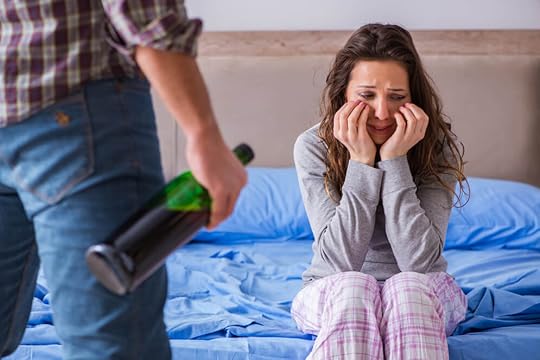
If you���re in the first quarter of your draft, all the guidance I���ve offered might help you to generate a clearer goal for your character by dealing a blow to something they already value. But it���s important to remember that the character���s motivation needs to reflect their initial fear, or misbelief, until the 25% mark (Point of No Return). At that point, the motivation will then shift away from their old fear, letting it go, and replacing it with a different fear���not attaining what they actually need���even if the external goal stays the same.
In other words, at that first-quarter mark, your character���s external goal may or may not change after the Point of No Return. Katniss continues to want to win the Hunger Games for the length of the story. But the fear fueling the why changes.
The motivation of what your character is scared to lose evolves so that around 25%, they must choose to let go of what they initially feared losing, and instead, go after something representative of a bigger loss should they not attain it. A fear that outweighs the fear they had in the beginning. And oftentimes, that fear can be facing, wrestling, and coming to terms with a hard truth related to that initial fear.
In Katniss��� case, she starts to see there isn���t any safety for her sister within their wider dystopian world, regardless of what Katniss tries to do. She has to let go of that protective role and risk dying in order to face a bigger fear���a world like the one they live in. Her motivation pivots toward impacting the larger world conflict in hopes that she can make it better for many more people.
What does your character fear losing when we meet them? If they don���t yet have a clear external goal, what could happen that might threaten their ability to avoid that fear? Does the decision they make then give rise to a concrete goal, still driven by their attempt to avoid their fear? At the Point of No Return, are you able to stick with the same external goal but fuel it by another healthier fear? Or, does your character���s goal change to reflect the fear of losing what they truly needed all along?
Happy writing!The post Three Easy Steps to Generate a Goal Using Fear as Motivation appeared first on WRITERS HELPING WRITERS��.
April 13, 2024
Character Type & Trope Thesaurus: Hotshot
In 1959, Carl Jung first popularized the idea of archetypes���”universal images that have existed since the remotest times.” He posited that every person is a blend of these 12 basic personalities. Ever since then, authors have been applying this idea to fictional characters, combining the different archetypes to come up with interesting new versions. The result is a sizable pool of character tropes that we see from one story to another.
Archetypes and tropes are popular storytelling elements because of their familiarity. Upon seeing them, readers know immediately who they’re dealing with and what role the nerd, dark lord, femme fatale, or monster hunter will play. As authors, we need to recognize the commonalities for each trope so we can write them in a recognizable way and create a rudimentary sketch for any character we want to create.
But when it comes to characters, no one wants just a sketch; we want a vibrant and striking cast full of color, depth, and contrast. Diving deeper into character creation is especially important when starting with tropes because the blessing of their familiarity is also a curse; without differentiation, the characters begin to look the same from story to story.
But no more. The Character Type and Trope Thesaurus allows you to outline the foundational elements of each trope while also exploring how to individualize them. In this way, you’ll be able to use historically tried-and-true character types to create a cast for your story that is anything but traditional.

DESCRIPTION: Talented and successful in their field, this character is cocky and loves taking risks. While hotshots have often been written with static arcs (as characters whose flaws don���t need addressing) recent years have seen a revisitation of these characters as ones with weaknesses that need to be addressed.
FICTIONAL EXAMPLES: Jack Reacher (the Jack Reacher series), James Bond (the James Bond series), Maverick (Top Gun), Han Solo (A New Hope), Axel Foley (Beverly Hills Cop)
COMMON STRENGTHS: Adaptable, Alert, Bold, Charming, Confident, Courageous, Decisive, Efficient, Focused, Independent, Industrious, Intelligent, Observant, Passionate, Perceptive, Persistent, Resourceful, Spontaneous, Talented
COMMON WEAKNESSES: Abrasive, Addictive, Cocky, Compulsive, Confrontational, Impatient, Impulsive, Inflexible, Irresponsible, Macho, Obsessive, Rebellious, Reckless, Self-Destructive, Stubborn, Uncooperative, Vindictive
ASSOCIATED ACTIONS, BEHAVIORS, AND TENDENCIES
Refusing to follow rules or protocol
Preferring to work alone
Being able to read a room and assess people and threats
Being an adrenaline junkie
Freely speaking their mind
Being expert in a certain area (marksmanship, flying a plane, fighting, gambling, etc.)
Not caring what others think of them
Tending toward risk-taking and recklessness
Thinking they know best
Disregarding customs and traditions that get in the way of the job
Having an addictive personality
SITUATIONS THAT WILL CHALLENGE THEM
Being paired with an incompetent partner
Being in a situation where the rules must be strictly followed
Having a superior who is a rule-follower or micro-manager
Being forced to compromise their beliefs or practices
Being ignored or minimized
TWIST THIS TROPE WITH A CHARACTER WHO���
Is exceptional in some way but otherwise lives an average, simple life
Has a surprising or mundane hobby
Has an atypical trait: Nature-Focused, Nurturing, Spiritual, Pensive, Worrywart, etc.
CLICH��S TO BE AWARE OF
The loner hotshot who can���t get along with anyone
Loose cannons who are respected but mistrusted by colleagues
Other Type and Trope Thesaurus entries can be found here.
 Need More Descriptive Help?
Need More Descriptive Help?While this thesaurus is still being developed, the rest of our descriptive collection (16 unique thesauri and growing) is accessible through the One Stop for Writers THESAURUS database.
If you like, swing by and check out the video walkthrough for this site, and then give our Free Trial a spin.
The post Character Type & Trope Thesaurus: Hotshot appeared first on WRITERS HELPING WRITERS��.
April 11, 2024
What is an Emotion Amplifier?
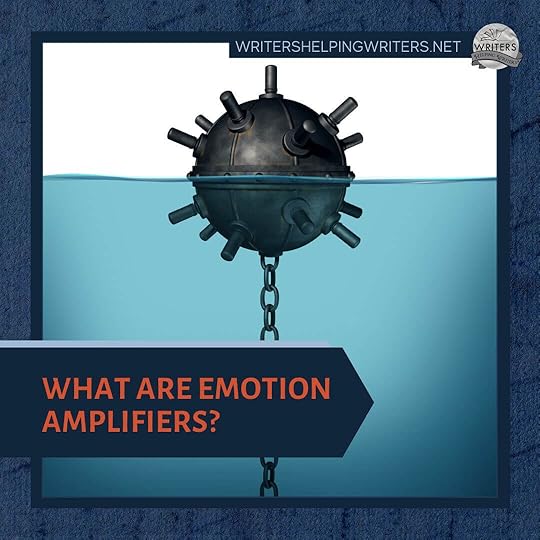
Since compiling our original Emotion Amplifier ebooklet in 2014, Angela and I have discovered so much about them. They’re way more versatile than we first imagined, and we’re stoked to share what we’ve learned with you in the soon-to-be-released 2nd edition of The Emotion Amplifier Thesaurus (which will be available everywhere May 13th).
But you know we can’t wait for the book to come out before we start talking your head off on this topic ;). If you’re a regular at the blog, you’re probably familiar with how these little cattle prods can get a character moving in the right direction. But for some of you, amplifiers are brand new, so I���d like to offer a quick introduction to what they are and what they can do for you and your story.
What is an Emotion Amplifier?We all know the importance of tapping into our character���s feelings and conveying those clearly to readers. When we do this, readers connect with our characters and become invested in the story. This is how we keep them engaged beyond the first few pages or chapters.
But sometimes our characters don���t want to ���go there��� emotionally. Maybe they���re resistant to change and have a death grip on the status quo. They might be uncomfortable with certain emotions and will try to hide or repress them. Un-dealt-with trauma may cause them to avoid their feelings. There are a lot of reasons a character might need an extra push to get them out of their emotional comfort zone. And the best way to do this is with an amplifier.
EMOTION AMPLIFIERS are specific states or conditions that influence what the character feels by disrupting their equilibrium and reducing their ability to think critically.
Distraction, bereavement, and exhaustion are examples. Emotionally speaking, these states destabilize the character and nudge them toward poor judgments, bad decisions, and mistakes���all of which result in more friction and increased tension in the story.
Case Study: An Amplifier in Action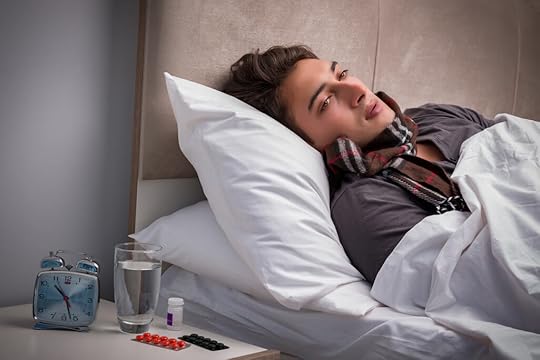
Consider Jake, a character who awakens to hot fingers of illness creeping through his body. On the cusp of a long-overdue promotion, he doesn���t dare call in sick, so he showers and heads to work. At the warehouse, he climbs into a forklift and begins his day of moving pallets and loading trucks in the pickup bay. Two guys on his crew haven���t shown up, making the shift even rougher. Everything requires more effort. Jake���s head buzzes. Noises bug him. He feels like he���s moving through molasses, but he���s got to work at double speed. As he rushes back and forth across the floor, he���s growing lightheaded. Where the heck is his foreman, who promised to pitch in?
Can you feel the strain Jake is under and how close his emotions are to the surface? How long until the weight of sickness causes him to snap at a co-worker, make a rash decision, or become so flustered he injures someone?
Amplifiers are an added condition or situational burden that must be coped with on top of everything else. They���re a challenge, conflict, and emotional destabilizer rolled into one, capable of causing physical, emotional, and psychological discomfort. The presence of an amplifier makes it harder for a character to think things through and stay in control of their emotions. And if characters become more volatile or lower their guard because they���re distracted, they���re more likely to miss something important and mess up.
Let���s say Jake���s dulled reflexes cause him to drop a pallet of product, ruining the inventory and creating a safety hazard. He���s reprimanded by his foreman, who never did come to help but has plenty of criticism to hand out. Hot with fever and frustration, Jake goes off about how he���s always the one who shows up, even when he���s sick, but never gets any appreciation. One outburst and a few ill-advised words later, Jake���s hopes for a promotion lie in ruins among the crushed cargo.
Emotion amplifiers, both large and small, are ideal for pushing a character over the edge���and sometimes, that���s exactly what the writer needs to happen. Smart, savvy characters who always make the right choices aren���t very interesting, but characters who blunder, lose control, or forget their filter? Now we���re talking!
The Ultimate Amplifier ResourceAngela and I have been studying amplifiers since we drafted the first copy of The Emotion Thesaurus. At that time, we kept running across things a character could technically feel���cold, hunger, attraction���that weren���t emotions. Eventually, we realized that these were states and conditions that intensified a character���s feelings and pushed them toward bigger reactions. Because they didn���t fit as emotions, we created an ebooklet for them: Emotion Amplifiers, a companion to The Emotion Thesaurus that highlighted 15 of these states.
But as time went on, we discovered many more amplifiers to be explored. We also realized that they do much more than just alter a character���s emotional state; they also serve as catalysts for conflict and tension, magnify internal dissonance and psychological distress, and even support story structure. Because of their versatility in strengthening both characters and stories, we knew we had to get the word out.

So we���re expanding our little ebooklet into a full-fledged book with 52 amplifiers (see the complete list here!) and a whole new front matter section that shows writers how to put them to work.
Are you curious? If so, we���ve provided a sample entry for you���a really versatile amplifier that every character will encounter at some point in the story.
Keep your eyes peeled over the next few months for more blog posts, writing tips, and instructive content on amplifiers and how to put them to use. And if you’d like to be notified when the new book hits the shelves, sign up for our New Release Notification newsletter.
The post What is an Emotion Amplifier? appeared first on WRITERS HELPING WRITERS��.
April 9, 2024
Top Story World and Story Bible Tips

When we create a story world for readers, we are implanting images and sensory details. From which, the reader fills in the gaps. If we skew that world in any way, we pull the reader out of their base model. And ultimately, out of the story itself.
Examples of Oopsies:blue eyes turn browna limp or lisp mysteriously vanishesthe sun rises outside the west-facing windowan ocean appears in the middle of the desertthe MC���s house has hardwood floors, yet in the previous book they had wall-to-wall carpetingCreating a fictional world requires creativity, consistency, and attention to detail.
10 Tips to Ensure a Smooth Transition from One Book to AnotherCreate an overarching series bible and a story bible for individual book(s). The story bible contains things like:
 Description of main characters, including the correct spelling of their namesDescription and names of secondary charactersDescription of villains, including epithets (if applicable)Victim profiles (if important)Characters��� professionsKiller(s) MO and/or signature (if applicable)Pets, including deceased pets (if applicable)Tattoos or piercingsScars���emotional and physicalFavorite jewelryMarital status/relationshipsImportant dates (birthdays/anniversaries)Family tiesThemesSettingBackstoryHousingFavorite scent (cologne/perfume/shampoo/body spray/lotion)Accent (if any)Home d��cor and architectureCherished treasures/family heirloomsTimelinesMain plotsSubplotsFuture scene ideas
Description of main characters, including the correct spelling of their namesDescription and names of secondary charactersDescription of villains, including epithets (if applicable)Victim profiles (if important)Characters��� professionsKiller(s) MO and/or signature (if applicable)Pets, including deceased pets (if applicable)Tattoos or piercingsScars���emotional and physicalFavorite jewelryMarital status/relationshipsImportant dates (birthdays/anniversaries)Family tiesThemesSettingBackstoryHousingFavorite scent (cologne/perfume/shampoo/body spray/lotion)Accent (if any)Home d��cor and architectureCherished treasures/family heirloomsTimelinesMain plotsSubplotsFuture scene ideasIn the story bible for each book, focus on minute details. Did you describe the MC���s home? Include the passage. Does the MC read a lot? Include book titles, if mentioned in the novel. Did you describe the town or the MC���s favorite breakfast joint? Include the passage.
The series bible should include details about the story world and generalized descriptions of the characters.
No need to repeat the descriptions of main and secondary characters unless they���ve changed in some way i.e., MC got a small ankle tattoo in the last book. Or she now has a scarred cheek from an automobile accident. Breast implants, liposuction, collagen lips, Botox, or other plastic surgery.
Do include theme, subplot, setting, ringtones, pets, updated backstory to include previous books, new characters, new fears, or old traumas resurfacing, new or perfected skills, favorite foods, favorite cocktail(s), food allergies, jobs, etc. etc. etc.
We forget. A lot. With multiple books in a series, our recall worsens. If we write in more than one series, it���s even easier to forget minute details.
Tips to Create Story WorldsEstablish a Core Concept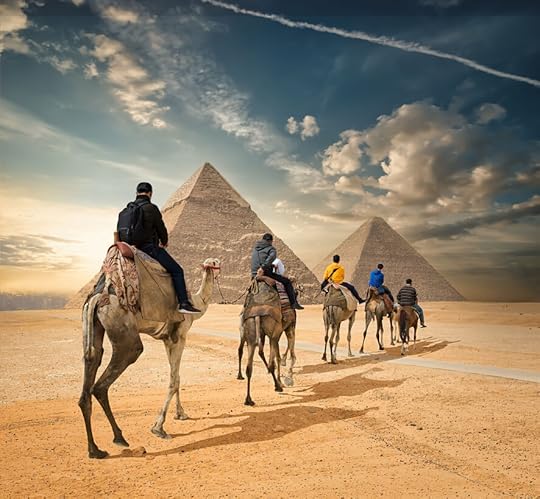
What is the concept or theme? Is the book set in a post-apocalyptic world? Dystopian future? Historical time? When or where does the story take place? Even if you never include the month or year in the WIP, knowing the approximate date helps to establish weather patterns, sunrise/sunset times, etc.
GeographyDevelop physical landscapes, landmarks, cultures, and traditions. What are the residents like in this town? Stepford-esque? Back-country rural? A bustling city? Beach/island community?
HistoryEven if you never use these details in the WIP, you should know the history of your world. Did a major event cause an upheaval? Are there lingering effects? What are the natural resources? What is the terrain and climate like? Any landmarks?
Culture and SocietyWho inhabits your world? What is the culture like? How is the diversity? Does the culture and/or society cause conflict? How so? What���s the transportation like���horses, vehicles, taxis, buses, bicycles, motorcycles, or do most people drive mopeds or golf carts on the streets?
LanguagesWhat is the predominate language of your world? Any secondary languages? Do language barriers cause conflict for the MC?
Societal Norms and TaboosWhat are societal norms for your world? Is there an Amish community? Is there a robust Indigenous community? Do their traditions and culture conflict or complement the MC���s background? Any taboos?
Leave Room for ChangesDon���t describe your story world in so much detail that it doesn���t allow for deeper exploration in later books. You may love it today, but ten books later it could hamstring you.
We can either create a story bible during the writing process or after. I prefer to do it once the first draft is complete. If I stop to scrawl notes during the drafting stage, it slows me down. Do whatever works best for you. These are guidelines, not rules.
Did I miss anything? Please share.Any other advice from your experience?
The post Top Story World and Story Bible Tips appeared first on WRITERS HELPING WRITERS��.
April 6, 2024
Character Type & Trope Thesaurus: Psychopath
In 1959, Carl Jung first popularized the idea of archetypes���”universal images that have existed since the remotest times.” He posited that every person is a blend of these 12 basic personalities. Ever since then, authors have been applying this idea to fictional characters, combining the different archetypes to come up with interesting new versions. The result is a sizable pool of character tropes that we see from one story to another.
Archetypes and tropes are popular storytelling elements because of their familiarity. Upon seeing them, readers know immediately who they’re dealing with and what role the nerd, dark lord, femme fatale, or monster hunter will play. As authors, we need to recognize the commonalities for each trope so we can write them in a recognizable way and create a rudimentary sketch for any character we want to create.
But when it comes to characters, no one wants just a sketch; we want a vibrant and striking cast full of color, depth, and contrast. Diving deeper into character creation is especially important when starting with tropes because the blessing of their familiarity is also a curse; without differentiation, the characters begin to look the same from story to story.
But no more. The Character Type and Trope Thesaurus allows you to outline the foundational elements of each trope while also exploring how to individualize them. In this way, you’ll be able to use historically tried-and-true character types to create a cast for your story that is anything but traditional.

DESCRIPTION: This narcissistic and antisocial character lacks empathy and will cross any line to get what they want.
FICTIONAL EXAMPLES: Anton Chigurh (No Country for Old Men), Annie Wilkes (Misery), Amy Dunne (Gone Girl), the Joker (The Dark Knight), Patrick Bateman (American Psycho)
COMMON STRENGTHS: Adaptable, Adventurous, Charming, Confident, Focused, Observant, Private, Spontaneous
COMMON WEAKNESSES: Antisocial, Callous, Controlling, Cruel, Dishonest, Evil, Haughty, Hostile, Impatient, Impulsive, Irresponsible, Manipulative, Rebellious, Reckless, Self-Indulgent, Selfish, Uncooperative, Unethical, Vain, Violent
ASSOCIATED ACTIONS, BEHAVIORS, AND TENDENCIES
Remaining cool under pressure
Acting assertively and decisively
Maintaining a singular focus on their goals
Being highly adaptable
Communicating strongly and effectively
Paying keen attention to details
Being confident
Showing resiliency in the face of setbacks
Being cruel for their own satisfaction or personal gain
Refusing to accept responsibility for their actions
Choosing relationships based on what the other person can do for them
SITUATIONS THAT WILL CHALLENGE THEM
Having to maintain a fa��ade of emotional intimacy and normal emotional range in a long-term relationship
Their lies and manipulation being exposed
Facing legal or social repercussions for their actions
TWIST THIS TROPE WITH A CHARACTER WHO���
Forms a genuine connection with another person
Has an atypical trait: Hospitable, Affectionate, Wholesome, Gossipy, Responsible, etc.
CLICH��S TO BE AWARE OF
The sadistic serial killer who enjoys causing pain and chaos and who is evil for evil���s sake
The unemotional, superhuman genius who is an unstoppable force with no regard for the consequences of their actions
The psycho who uses his tendencies for the greater good and becomes an unconventional hero or antihero (�� la Dexter Morgan)
Other Type and Trope Thesaurus entries can be found here.
 Need More Descriptive Help?
Need More Descriptive Help?While this thesaurus is still being developed, the rest of our descriptive collection (16 unique thesauri and growing) is accessible through the One Stop for Writers THESAURUS database.
If you like, swing by and check out the video walkthrough for this site, and then give our Free Trial a spin.
The post Character Type & Trope Thesaurus: Psychopath appeared first on WRITERS HELPING WRITERS��.
April 4, 2024
How to Combine Myth with History to Create Historical Fantasy
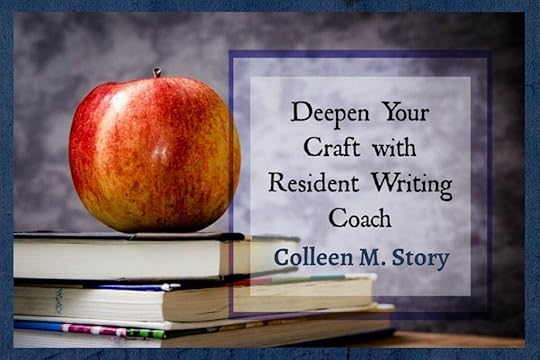
Three years ago, I never would have guessed I���d be writing a blog post on this topic.
Back then, I was focused on pure fantasy stories. My first novel was an epic fantasy, while my second and third were paranormal fantasy.
I thought I had ���found my voice��� in paranormal fantasy, but then a friend of mine asked me a question:
���Would you like to write a book about the King Midas myth?���
That question, and my answer to it������Sure, I could give it a try������opened up a whole new world for me in terms of fantasy writing.
Why?
Because when I started researching the King Midas myth, I discovered something very interesting: King Midas was a real person.
It���s Fun to Find History in MythKing Midas, according to the latest research by the University of Pennsylvania, ruled the kingdom of Phrygia back in the later 600s and early 700s BC.
As far as the records show, this is the same Midas the Greeks were talking about when they created the King Midas myth���you know, the one about him asking the god Dionysus for the touch of gold. When I found this in my research, I was super excited. Not only did I have the myth to play with in my story, now I had the real life of King Midas, too. Combining them both in a new narrative opened up creative avenues I would have never explored before.
Writing the story was a lot of fun, and though I didn���t plan it that way, ���The Curse of King Midas��� has now spawned a series called The Midas Legacy. I���m knee-deep in book two at the time of this writing.
What I���d like to share with other writers is the fun that can be had when you try this type of setup for your story. If you���d like to explore something new or get out of a rut, I urge you to give it a try!
It���s Up to You How Much You Use of Either OneThe main question I had getting into the story���and the one I still find myself asking as I look ahead to books two and three���is how much to pull from the real history and how much to use of the myth.
With this story, it made the most sense to rely heavily on the myth. This is what most people are familiar with when it comes to Midas. I���ve read other authors like Gregory Maguire (Wicked) and Madeline Miller (Circe) and I could recognize the main story (The Wizard of Oz and The Odyssey, respectively) within their novels. It was important to me to have the same recognition in my book about Midas, as readers attracted to the title will be looking for that.
I did change some things, though. The main one was Midas��� motivation. In the myth, he���s motivated strictly by greed. I couldn���t relate to that. Nor could I imagine a father as devoted to his daughter as Midas was risking it all for gold coins. So I shifted his motivation to something I felt was more relatable and greatly increased the stakes of the story: revenge.
I also played with some of the main characters, and here is where the real history helped me a lot. I needed a rival for Midas, and history gave it to me. According to the records that survived that time, King Sargon II���who ruled Assyria���found King Midas to be a pain in his behind. He often had to face him in battles and didn���t like that he was trying to squelch his expansion plans.
My research on King Sargon II helped me form his character in the story, and he turned out to be the perfect antagonist. He added a lot more drama and action to the story, which was just what the myth needed.
History Can Supply the Time and Setting
The other thing that I pulled from the history of King Midas was the time and setting. Whereas the myth is set in a general time in the past, the real King Midas��� life spanned a limited number of years in a very specific time. This helped create guardrails for my novel in terms of how people lived then and what sort of tools they had.
I was also delighted to discover that archaeologists were in the process of excavating the city of Gordion as I was writing! This is the capital city from where King Midas ruled. It was an amazing coincidence, and I���ve stayed as true as I could to the location of the city at that time.
The geography and the climate were already decided for me���I didn���t have to make them up. It also made creating the map that sits at the front of the book a lot easier!
A Basis for a SeriesThe last thing history gave me was a way to carry on with the story past the original myth. I didn���t expect that Midas would spawn a series, initially. Book one has a satisfying ending, but it does leave some questions unanswered, particularly concerning a couple of key characters. When my beta readers started asking me if there was going to be a sequel, I knew I had more in this world to explore.
I���ve returned to what really happened during that time as the basis for the second book. It���s presented some challenges for me, in terms of how it has to end. But I like a challenge and have enjoyed tackling a type of story I might not have tried otherwise. And I think it will naturally lead into the third and final book, though what will happen then I don���t know yet!
Might You Like to Combine Myth with History?If you���re considering this type of approach to a story, here are some advantages I���ve found:
The myth and the history together will present a ready-made plot, or at least the foundation of it. That can give you a jumpstart on plotting, making it a little easier.The history can give you time and place���making the setting simpler to create. (The research is fun too.)The myth can provide fun fantasy elements to include. (I used the gods and their magic to plant the story firmly in fantasy territory.)Overall, this was a fun story to write. As a writing exercise, you may want to try combining one of your favorite myths or fairy tales with a certain time in history, just to see what you might come up with.
Note: To get a glimpse of Colleen���s new book, The Curse of King Midas, click here!
The post How to Combine Myth with History to Create Historical Fantasy appeared first on WRITERS HELPING WRITERS��.
Writers Helping Writers
- Angela Ackerman's profile
- 1022 followers



